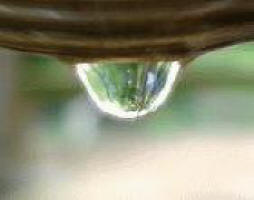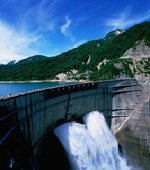 Middle East: Water treatment kit for household grey water
Middle East: Water treatment kit for household grey water
A
kit designed to treat household waste water for reuse could be one of
the ways to tackle water scarcity in rural areas of the Middle East and
North Africa, according to a Canadian organisation.
“This is a household-based technology mainly for rural areas to treat
grey water that comes from the kitchen sink and bath for re-use,” said
Hammou Laamrani, project coordinator at the Regional Water Demand
Initiative of the International Development Research Centre (IDRC),
based in Canada.
“It is a very simple, easy to manipulate, inexpensive water treatment
kit which can be handled without special training and technological
skills, and can be used in the context of poor and marginalised
communities,” Laamrani told IRIN in Istanbul at the World Water Forum.
Grey water, also called `sullage’, is non-industrial wastewater
generated from domestic processes such as dish washing, laundry and
bathing. Greywater comprises 50-80 percent of residential wastewater - everything from the home, except blackwater, or sewage.
The
kit consists of two large PVC barrels about 1.2m high, each able to
contain up to 200 litres of water, pipes and sand. Before reaching the
barrels, the waste water goes through a separate filter where things
like small bits of food are removed. The barrels are filled with sand;
there is an anaerobic digestion of the organic matter when the water
goes through the sand filter and becomes cleaner.
“The
quality of the treated water is improved chemically and biologically;
it [the filter] removes the pathogens, particularly the E. coli
that could pose a health risk. It also removes parasite eggs as they
cannot go through the filter because the filter is a kind of a
bio-membrane that removes all those things,” Laamrani explained.
Benefits
It has a socio-economic impact, it has a positive impact on the
environment and it’s viable in terms of technology used,” Laamrani
said.
Waste water treated by sand filter has very little nitrogen and
potassium, and in terms of chemical pollution poses no risk for the
soil, according to Laamrani. It is not a risk to soil because it does
not have mineral components that can increase soil salinity and
degradation, and it is not a risk to human beings in terms of exposure
to pathogens, he said.
“It reduces the amount of water that goes into cesspits - sanitation in
rural areas. So they don’t need to clean the cesspit so often - only
once every three months, instead of once a week. This reduces the cost
of emptying the cesspits,” he said.
“This
water can also be used for productive purposes. It is used for the
irrigation of saplings, particularly olive trees like we saw in Jordan…
This water can also be reused in the household, like for flushing
toilets,” he said.
However, it is not suitable for crops or vegetables consumed without cooking, like cucumbers and tomatoes, he said.
“The cost of the kit is $300-400, and in some cases even less depending
on the price of components in any given market. If you take into
account the productive use of the treated waste water and the reduced
frequency of cesspit evacuation, outlay costs can be recouped in a year
in places like Jordan and Lebanon,” the IDRC official said, adding that
they also had projects in the occupied Palestinian territories and
Yemen.
Maintenance is simple: sand in the barrels needs to be changed every 10-15 years, Laamrani said.
Challenges
One of the drawbacks with the system initially was the smell: “There
was no technology to remove the smell when the water was in the
barrels. But it has been overcome with a new system that takes the gas
out of the barrels… No longer is there a risk of attracting ants or
other insects,” he said.
“We expect governments and development agencies to be engaged at this
stage, but this is not yet happening,” he said, adding that there was a
need for an effort to make such solutions popular. “A social marketing
exercise is needed to promote it, but we cannot do that ourselves
because our role is to see whether this works, and when it works we
will tell people.”
Laamrani said that there was no single solution to the water problem in
North Africa and the Middle East but that all options should be kept
open.
Premature?
Some researchers say scaling up household water treatment is premature, and that more research is needed before it can be recommended to policy-makers.
Wolf-Peter Schmidt and Sandy Cairncross from the London School of
Hygiene and Tropical Medicine said in a report published by the Environmental Science and Technology journal
that the household water treatment (HWT) had been advocated as a means
to substantially decrease the global burden of diarrhoea and to
contribute to the Millennium Development Goals.
"To
determine whether HWT should be scaled up now, we reviewed the evidence
on acceptability, scalability, adverse effects, and nonhealth benefits
as the main criteria to establish how much evidence is needed before
scaling up. We found that the acceptability and scalability of HWT is
still unclear, and that there are substantial barriers making it
difficult to identify populations that would benefit most from a
potential effect," the authors said.
"The nonhealth benefits of HWT are negligible. We conclude that
widespread promotion of HWT is premature given the available evidence.
Further acceptability studies and large blinded trials or trials with
an objective health outcome are needed before HWT can be recommended to
policy-makers and implementers," they added.
| Contact information |
Doaa Arafa
(email: DArafa@idrc.org.eg) |
|---|---|
| News type | Inbrief |
| File link |
http://www.irinnews.org/Report.aspx?ReportId=83579 |
| Source of information | Irin News - © IRIN 2009. |
| Keyword(s) | Water treatment, household grey water |
| Subject(s) | ANALYSIS AND TESTS , CHARACTERISTICAL PARAMETERS OF WATERS AND SLUDGES , DRINKING WATER , DRINKING WATER AND SANITATION : COMMON PROCESSES OF PURIFICATION AND TREATMENT , METHTODOLOGY - STATISTICS - DECISION AID , POLICY-WATER POLICY AND WATER MANAGEMENT , SANITATION -STRICT PURIFICATION PROCESSES , SLUDGES , WATER DEMAND , WATER QUALITY |
| Relation | http://www.idrc.ca/en/ev-100648-201-1-DO_TOPIC.html |
| Geographical coverage | International |
| News date | 23/03/2009 |
| Working language(s) | ENGLISH |
 you are not logged in
you are not logged in





